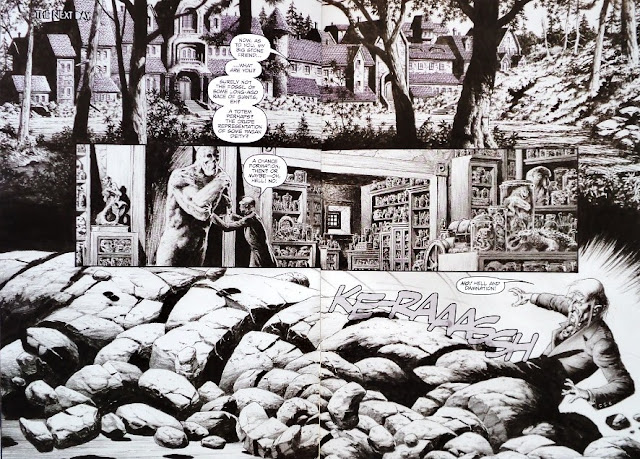Buried below the foundations of an unassuming building, the Planetary team discovers a spaceship, a gigantic structure slightly reminiscent to a cathedral. However, even with the assistance of dozens of scientists and researchers, they cannot gain access to this mysterious vessel.
Then an accident happens. Jim, a man who was not supposed to be there, stumbles onto the hull of the ship and creates a dimensional rift. Suddenly, he is trapped inside. And what he sees is something that defies his imagination.
Warren Ellis presents to us the idea of an intelligent spaceship, one with a conscious; a veritable life form with circuits instead of veins, navigation systems instead of synapsis and organic fuel instead of blood. But it has been designed to be piloted by complex minds, and since its crew died eons ago, the ship has remained dormant, forever entombed in an alien world: Earth.
The ship collided against our planet not thousands but millions of years ago, when the dinosaurs still reigned supreme upon the continent later known as America. For millions of years, the vessel has been waiting to be rescued, and now Jim can be its pilot.
 |
| Jim steps onto the hull / Jim pisa el casco |
For the first time since the beginning of the series, Elijah Snow comes to a logical conclusion. Planetary can no longer be a passive organization, they can't simply excavate otherworldly relics from the past, they need to step up their game and be as proactive as they can be. And so he decides to help Jim, who is now the pilot of an alien transportation system.
John Cassaday’s art in this issue is absolutely exquisite. A clean design and inspired lettering are combined in a cover reminiscent of old magazines; there, Jim reminds us of Captain Marvel (both in attire and posturing). The page that shows Jim stepping onto the ship’s hull is an amazing exercise of perspective. On the first panel, we get to see the entire scene diagonally and from above; and in panels 2 and 3 the camera descends progressively.
In the next page, architecture shines through, Cassaday’s astonishing imagination is unleashed in this collection of Corinthian columns, art deco pillars, Renaissance vault ceilings and cathedral stained glass windows. I can only think of two artists that have impressed me so much with architecture: Cassaday and Barry Windsor-Smith. Finally, the collision of the celestial cathedral in the Jurassic period is spectacular, and the tour around the ship that Jim shares with Elijah Snow, Jakita Wagner and Drummer is outstanding.
 |
| Inside the celestial cathedral / dentro de la catedral celestial |
________________________________________________________________________________________________
________________________________________________________________________________________________
 |
| Collision during the Jurassic period / colisión durante el periodo jurásico |
Hasta ahora los Arqueólogos de lo Imposible han estado lidiando con los secretos del siglo XX, pero esta vez, entre los restos de un edificio de oficinas destruido, encuentran algo más, algo único, algo más antiguo que la humanidad.
Enterrado debajo de los cimientos de un modesto edificio, el equipo de Planetary descubre una nave, una gigantesca estructura ligeramente reminiscente a una catedral. Sin embargo, incluso con la ayuda de docenas de científicos e investigadores, no pueden acceder a este misterioso bajel.
Es entonces cuando ocurre un accidente. Jim, un hombre que no debería haber estado allí, se topa con el casco de la nave y crea una fisura dimensional. Repentinamente, está atrapado en el interior. Y lo que ve desafía su imaginación.
Warren Ellis nos presenta la idea de una nave inteligente, con conciencia; una verdadera forma de vida con circuitos en vez de venas, sistemas de navegación en vez de sinapsis y combustible orgánico en vez de sangre. Pero ha sido diseñada para ser piloteada por mentes complejas, y como la tripulación murió hace eones, la nave ha permanecido dormida, para siempre enclaustrada en un mundo alienígeno: la Tierra.
La nave chocó con nuestro planeta no hace miles sino millones de años, cuando los dinosaurios aún reinaban supremos en el continente que después sería conocido como América. Por millones de años, el bajel ha estado esperando a ser rescatado, y ahora Jim puede ser su piloto.
 |
| Jim, Elijah Snow, Jakita Wagner & Drummer |
Por primera vez desde el inicio de la serie, Elijah Snow llega a una conclusión lógica. Planetary ya no puede ser una organización pasiva, no pueden simplemente excavar las reliquias de un pasado que no pertenece a nuestro mundo, necesitan mejorar y ser mucho más proactivos. Así que él decide ayudar a Jim, quien ahora es el piloto de un sistema de transporte alienígeno.
En este número, el arte de John Cassaday es absolutamente exquisito. Un diseño limpio y un inspirado rotulado se combinan en una portada reminiscente de las viejas revistas; allí, Jim nos recuerda a Captain Marvel (tanto en el traje como en la postura). La página que muestra a Jim pisando el casco de la nave es un asombroso ejercicio de perspectiva. En la primera viñeta, vemos toda la escena diagonalmente y desde arriba; y en las viñetas 2 y 3, la cámara desciende progresivamente.
En la página siguiente, la arquitectura brilla, la asombrosa imaginación de Cassaday se desata en esta colección de columnas corintias, pilares art deco, bóvedas del Renacimiento y vitrales de catedral. Sólo puedo pensar en dos artistas que me han impresionado tanto con la arquitectura: Cassaday y Barry Windsor-Smith. Finalmente, la colisión de la catedral celestial en el periodo jurásico es espectacular, y el paseo por la nave que Jim comparte con Elijah Snow, Jakita Wagner y Drummer es sobresaliente.
















